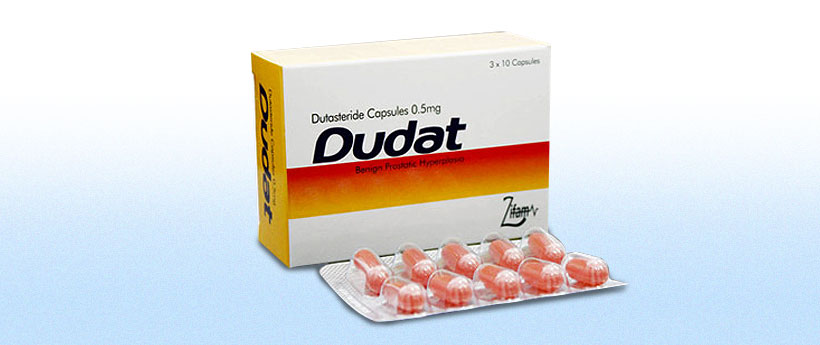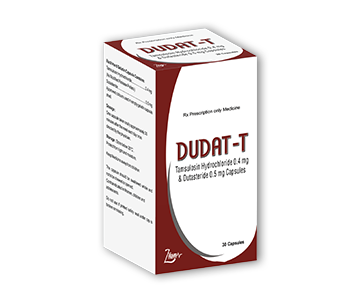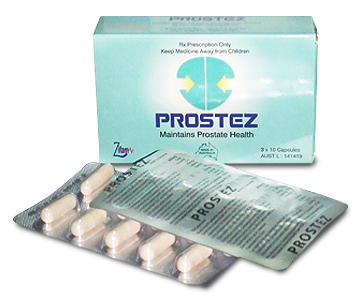Dudat
- ENG
- မြန်မာ

Each Soft Gelatin Capsule Contains:
Dutasteride BP 0.5mg
PHARMACOLOGICAL PROPERTIES:
Pharmacotherapeutic group: testosterone 5-alpha-reductase inhibitors
PHARMACODYNAMIC PROPERTIES:
Dutasteride reduces circulating levels of dihydrotestosterone (DHT) by inhibiting both type 1 and type 2, 5-alpha-reductase isoenzymes which are responsible for the conversion of testosterone to 5-alpha-DHT.
PHARMACOKINETICS:
Absorption
Following oral administration of a single 0.5 mg Dutasteride dose, the time to peak serum concentrations of Dutasteride is 1 to 3 hours. The absolute bioavailability is approximately 60%. The bioavailability of Dutasteride is not affected by food.
Distribution
Dutasteride has a large volume of distribution (300 to 500 L) and is highly bound to plasma proteins (>99.5%). Following daily dosing, Dutasteride serum concentrations achieve 65% of steady state concentration after 1 month and approximately 90% after 3 months.
Steady state serum concentrations (Css) of approximately 40 ng/mL are achieved after 6 months of dosing 0.5 mg once a day. Dutasteride partitioning from serum into semen averaged 11.5%.
Elimination
Dutasteride is extensively metabolised in vivo. In vitro, Dutasteride is metabolised by the cytochrome P450 3A4 and 3A5 to three monohydroxylated metabolites and one dihydroxylated metabolite.
Following oral dosing of Dutasteride 0.5mg/day to steady state, 1.0% to 15.4% (mean of 5.4%) of the administered dose is excreted as unchanged Dutasteride in the feaces. The remainder is excreted in the faeces as 4 major metabolites comprising 39%, 21%, 7% and 7% each of drug related material and 6 minor metabolites (Less than 5% each). Only trace amounts of unchanged Dutasteride (less than 0.1% of the dose) are detected in human urine.
The elimination of Dutasteride is dose dependent and the process appears to be described by two elimination pathways in parallel, one that is saturable at clinically relevant concentrations and one that is non saturable. At low serum concentrations (less than 3mg/mL), Dutasteride is cleared rapidly by both the concentration dependent and concentration independent elimination pathways. Single dose of 5mg or less showed evidence of rapid clearance and a short half-life of 3 to 9 days. At therapeutic concentrations, following repeat dosing of 0.5mg/day, the slower, linear elimination pathway is dominating and the half-life is approx. 3-5 weeks.
INDICATIONS:
Treatment of moderate to severe symptoms of benign prostatic hyperplasia (BPH). Reduction in the risk of acute urinary retention (AUR) and surgery in patients with moderate to severe symptoms of BPH.
CONTRAINDICATIONS:
Dutasteride is contraindicated in:
– Women and children and adolescents
– Patients with hypersensitivity to Dutasteride, other 5-alpha reductase inhibitors soya, peanut or any of the other excipients.
– Patients with severe hepatic impairment.
WARNINGS AND PRECAUTIONS:
Combination therapy should be prescribed after careful benefit risk assessment due to the potential increased risk of adverse events (including cardiac failure) and after consideration of alternative treatment options including monotherapies.
Effects on prostate specific antigen (PSA) and prostate cancer detection:
Digital rectal examination, as well as other evaluations for prostate cancer, must be performed on patients prior to initiating therapy with Dutasteride and periodically thereafter.
Serum prostate-specific antigen (PSA) concentration is an important component in the detection of prostate cancer. Dutasteride causes a decrease in mean serum PSA levels by approximately 50%, after 6 months of treatment.
Treatment with Dutasteride does not interface with the use of PSA as a tool to assist in the diagnosis of prostate cancer after a new baseline has been established.
Prostate cancer and high grade tumours:
Results of one clinical study(the REDUCE study) in men at increased risk of prostate cancer revealed a higher of Gleason 8-10 prostate cancers in Dutasteride treated men compared to placebo. The relationship between Dutasteride and high grade prostate cancer is not clear. Men taking Dutasteride should be regularly evaluated for prostate cancer risk including PSA testing.
Leaking capsules
Dutasteride is absorbed through the skin, therefore, women, children and adolescents must avoid contact with leaking capsules. If contact is made with leaking capsules, the contact area should be washed immediately with soap and water.
Hepatic impairment
Dutasteride was not studied in patients with liver disease. Caution should be used in the administration of Dutasteride to patients with mild to moderate hepatic impairment.
Breast neoplasia
Breast cancer has been reported in men taking Dutasteride in clinical trials and during the post-making period. Physicians should instruct their patients to promptly report any changes in their breast tissue such as lumps or nipple discharge. Currently it is not clear if there is a casual relationship between the occurrence of male breast cancer and long term use of Dutasteride.
INTERACTIONS:
Effects of other drugs on the pharmacokinetics of Dutasteride
Use together with CYP3A4 and/or P-glycoprotein-inhibitors:
Dutasteride is mainly eliminated via metabolism. In vitro studies indicate that this metabolism is catalysed by CYP3A4 and CYP3A5. No formal interaction studies have been performed with potent CYP3A4 inhibitors. However, in a population pharmacokinetic study, Dutasteride serum concentrations were on average 1.6 to 1.8 times greater, respectively, in a small number of patients treated concurrently with verapamil or diltiazem (moderate inhibitors of CYP3A4 and inhibitors of P-glycoprotein) than in other patients.
Long-term combination of Dutasteride with drugs that are potent inhibitors of the enzyme CYP3A4 (e.g. ritonavir, indinavir, nefazodone, itraconazole, ketoconazole administered orally) may increase serum concentrations of Dutasteride. Further inhibition of 5-alpha reductase at increased Dutasteride exposure, is not likely. However, a reduction of the Dutasteride dosing frequency can be considered if side effects are noted. It should be noted that in the case of enzyme inhibition, the long half-life may be further prolonged and it can take more than 6 months of concurrent therapy before a new steady state is reached.
Dutasteride has no effect on the pharmacokinetics of warfarin or digoxin. This indicates that Dutasteride does not inhibit/induce CYP2C9 or the transporter P-glycoprotein. In vitro interaction studies indicate that Dutasteride does not inhibit the enzymes CYP1A2, CYP2A6,CYP2E1,CYP2C8, CYP2D6, CYP2C9, CYP2B6 or CYP3A4.
In a small study (N=24) of two weeks duration in healthy men, Dutasteride (0.5mg daily) had no effect on the pharmacokinetics of tamsulosin or terazosin. There was also no indication of a pharmacodynamic interaction in this study.
PREGNANCY AND LACTATION:
Dutasteride is contraindicated for use by women.
Fertility
Dutasteride has been reported to affect semen characteristics (reduction in sperm count, semen volume, and sperm motility) in healthy men. The possibility of reduced male fertility cannot be excluded.
Pregnancy
As with other 5 alpha reductase inhibitors, Dutasteride inhibits the conversion of testosterone to dihydrotestosterone and may, if administered to a women carrying a male foetus, inhibit the development of the external genitalia of the foetus. Small amounts of Dutasteride have been recovered from the semen in subjects receiving Dutasteride 0.5mg day. It is not known whether a male foetus may be adversely affected if his mother is exposed to the semen of a patient being treated with Dutasteride (the risk of which is greatest during the first 16 weeks of pregnancy).
As with all 5 alpha reductase inhibitors, when the patient’s partner is or may potentially be pregnant it is recommended that the patient avoids exposure of his partner to semen by use of a condom.
Lactation
It is not known whether Dutasteride is excreted or not in human milk.
DOSAGE AND DIRECTIONS FOR USE:
Dutasteride can be administered alone or in combination with the alpha-blocker tamsulosin(0.4mg)
Adults(including elderly):
The recommended dose of Dutasteride is one capsule (0.5mg) taken orally once a day. The capsules should be swallowed whole and not chewed or opened as contact with the capsule contents may result irritation of the oropharyngeal mucosa. The capsules may be taken with or without food. Although an improvement may be observed at an early stage, it can take up to 6 months before a response to the treatment can be achieved. No dose adjustment is necessary in the elderly.
Renal impairment:
The effect of renal impairment on Dutasteride pharmacokinetics has not been studied. No adjustment in dosage is anticipated for patients with renal impairment.
Hepatic impairment:
The effect of hepatic impairment on Dutasteride pharmacokinetics has not been studied so caution should be used in patients with mild to moderate hepatic impairment. In patients with severe hepatic impairment, the use of Dutasteride is contraindicated.
SIDE-EFFECTS:
Reproductive system and breast disorders: Impotence Altered (decreased) libido, Ejaculation disorders, and Breast disorders.
Immune system disorders: Allergic reactions including rash, pruritus, urticaria, localised oedema, and angioedema
Neoplasms: Male breast cancer.
Psychiatric disorders: Depressed mood
Skin and subcutaneous tissue disorders: Alopecia (primarily body hair loss), hypertrichosis
Reproductive system and breast disorders: Testicular pain and swelling.
OVERDOSAGE
In volunteer studies of Dutasteride, single daily doses of Dutasteride up to 40 mg/day (80 times the therapeutic dose) have been administered for 7 days without significant safety concerns. In clinical studies, doses of 5 mg daily have been administered to subjects for 6 months with no additional adverse effects to those seen at therapeutic doses of 0.5 mg. There is no specific antidote for Dutasteride, therefore, in suspected over dosage symptomatic and supportive treatment should be given as appropriate.
PRESENTATION:
Blister pack of 3×10 capsules
STORAGE INSTRUCTIONS:
Store below 25°C. Protect from light and moisture.
Updated on February 9, 2024.







